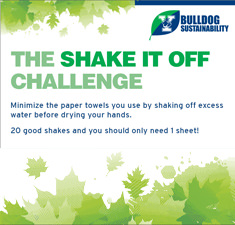
When you enter the cardio room at Payne Whitney Gym, posters remind you to turn off lights and take the stairs. On the machines you can plug in and charge a variety of cell phones, iPods, and other handheld devices using the very energy you are pouring into your workout. While the gym’s fluorescent lights might not denote a natural setting, the focus on sustainability is clear. In the fall of 2008, the Yale Athletics Department joined forces with the Office of Sustainability to green Yale’s athletic program. Four students were hired with the goal to “create a model of sustainable collegiate athletics that is measurable, transferable, and adaptable” and created Bulldogs Sustainability.
The work of the Bulldogs Sustainability team remained mostly behind the scenes last year; conducting research, collecting data, and meeting with coaches and teams to get a sense of their current habits. Since January however, the sustainability team has become much more visible with a major outreach program. At the January 16th Bulldog basketball game, the sustainability team told patrons of their progress at a booth and took the stage at the half-time show, challenging audience members to recycle (and, like any good half-time show, giving away free t-shirts). Soon thereafter, posters appeared around Payne Whitney Gym with images of the bulldog mascot reminding everyone from varsity athletes to recreational users to take shorter showers, turn off the lights, and consider sustainability in their everyday actions. “We’re hoping to raise awareness in a hands off way; trying to get people to think about how they can live sustainably,” explained Sam Teicher, a club rugby player who works on the Sustainable Athletics program.
However, the Bulldog Sustainability program is about more than simply turning off the lights and recycling sports drink bottles. While they do hope to affect the behavior of athletes and fans, the group has also encouraged the Athletics program to consider sustainability in less visible facets such as organic fertilizers and reduced pesticides for field maintenance and eco-friendly laundry detergent. These elements are less focused on engaging the athletes, but will benefit both the health of the athletes and the ecosystem.
There is no blueprint, explained Teicher, for a perfectly sustainable athletics program; in fact, the NCAA has even asked Bulldogs Sustainability to create a best practices database for sustainable athletics that will be applied to other institutions. “Sustainable athletics is a new concept. Several schools have implemented great strategies but many are focused solely on recycling.” Bulldogs Sustainability strives to go beyond the basics of recycling, looking at every major area of the athletics program and analyzing how it can become more sustainable. “Any idea is a possibility. We are drawing resources from other colleges and pro-sports teams but the majority of what we are doing has been conceived of on our own.”